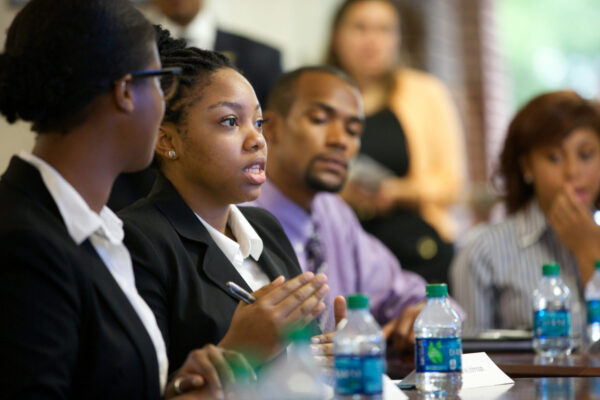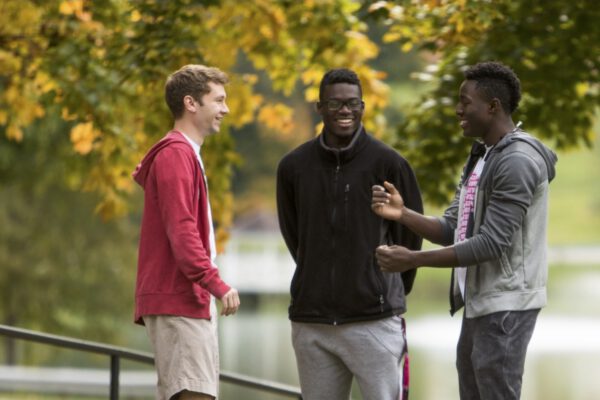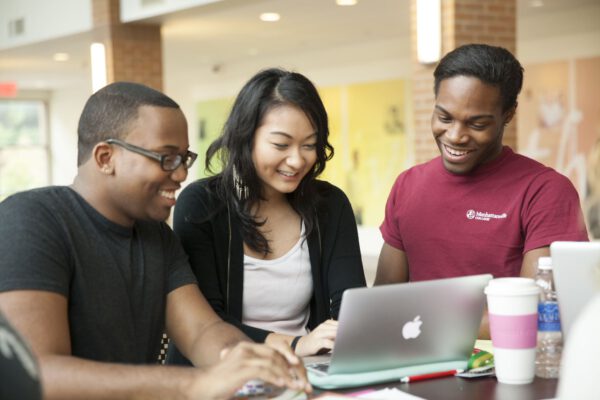In March 2019, ACE held a plenary session at its 101st Annual Meeting called “Talking About Race.” Continuing the discussion started by the panel, the Let’s Talk About Race interview series captures the voices of prominent higher education scholars and leaders as they share their perspectives and experiences on race and ethnicity in higher education. This work is part of ACE’s Race and Ethnicity in Higher Education: A Status Report project, which is sponsored by the Bill & Melinda Gates Foundation.
Q: What do you feel is the role of higher education in breaking down barriers across race?
I think the role of higher education in breaking down barriers around race has never been more important, for a couple of reasons. First, the good news, and one of the things that we were able to highlight in the Race and Ethnicity in Higher Education report, is that campuses are becoming more diverse, and racial diversity is a part of that. I think it speaks to the nation’s commitment to access over time. Higher education is in a primary place to then take that group of people and not only say, “Great, we’ve got a bunch of diverse students,” but help those students really understand what it means to live and thrive in a multiracial, multicultural community. So that’s, I think, the first part.
The second is that I think over that same period of time where we’ve promoted access to our institutions of higher education, American society as a whole has become more racially divided and more segregated. Our colleagues at UCLA have done a great job of highlighting this—whether you look at the resegregation of public schools in America or if you look at the persistent residential segregation, there are fewer and fewer opportunities, ironically, for people of different backgrounds to interact. College campuses remain one of those few places, and we need to make the most of it.
Q: Given your life experiences and professional preparation, how did you obtain a knowledge base in equity, diversity, inclusion, and social justice in higher education?
This goes back a long way for me. My dad was a high school counselor when I was growing up. And the school in which he was the counselor was the only racially mixed school in our county. It served a giant housing project, a 1960s-era housing project, and a suburban community around it. It was the Black and White school in our town.
I remember very clearly how hard he and his colleagues worked to create opportunities for the African American students who were a part of this mixed community. I remember how hard it was for him every year as he worked to find appropriate places in higher education for really talented Black students, who at that time were not getting anything close to equal opportunity, whether that was equal access to advanced placement courses or equal opportunity to attend selective colleges and universities. I can remember him just sitting at the dining room table in those days with stacks of file folders, and it would bring tears to his eyes to see the inequality.
I grew up with that. I grew up understanding that we all—as a family, me as an individual—we had a commitment to making things different. Initially I thought the way that I was going to do that was follow in his footsteps and be a high school teacher. Then I got to college, and really started to immerse myself more in the history and the economics of inequality, and was really drawn to education as a matter of social policy.
As, on the one hand, education has historically been one of the primary ways privilege has been reproduced in our country. And that’s what I experienced in watching my dad go through that work. But there’s always also been this glimmer of hope that education could be a tool for eliminating inequality and creating real opportunity. It was exactly at that tension point where I spent my time thinking about it as an undergraduate, and then a graduate student.
My graduate work was on the education of freed slaves in the South after the Civil War. And so this tension played out in extraordinary ways where you had the White, privileged Southern elite wanting to use education to keep freed slaves subservient in every possible way—economically, intellectually, socially. And you had the freed slaves themselves understanding that education could be, and symbolized for them, a route to real freedom. I grew up working on those issues and thinking about those issues.
So again, I have been at this for a very long time. I have deeply held personal views, deeply held intellectual views about these issues. And every job that I’ve taken in higher education has been a job that I have to test against whether it’s going to advance the cause of social justice or not. If the answer is no, I don’t take it.
Q: If you were to educate students differently so that they evolved into more critically conscious, equity minded citizens, how would you do it, if money were not a factor?
If I look at American society today, I am really struck by how easy it has become for people to live in silos of self-selection. That’s true residentially. It’s true in schools. It’s true online. It’s true in the very news that we get. I think we have to figure out ways of breaking that. Whether that’s breaking that through more effective means of creating integrated K–12 schools, whether it’s breaking that through creating real, honest approaches to residential integration in urban areas and in rural areas alike, whether that’s creating college campuses in which there are more opportunities for different students to interact in substantive ways—I think all of those are things that we need to do, and we need to think about some new things too.
Is it time for us to talk about national service as a way to bring people back together again? We’ve started to reflect in mythical ways about the so-called “greatest generation.” And our own field has been really changed by the G.I. Bill and the entrance of different undergraduates—not as many African Americans or Latinos as I think we sometimes think it was, but nonetheless, it was a real opportunity to diversify the collective experience of people from different backgrounds. Maybe it’s time for us to think about that again, to think about two years of national service for everybody in America, and to do it in such a way that Black people and White people and people from different socioeconomic backgrounds and rural kids and urban people get together and they’re together.
Importantly, we need to be clear that just putting people together isn’t enough. We need to be conscious about how to create those experiences in ways that allow people to learn from those differences, not simply draw back into those silos of self-selection.
I’ll say one more thing, which I think impacts the way we think about our own practice at a campus level. If you take this Deweyan notion that you learn best by doing things, and you track it through this idea of racial familiarity and understanding and building connections, then I think at some point we need to address the way we teach. We need to think about self consciously creating experiences for our students in which they interact with others they may not be familiar with and to have that be a part of what the learning is. It is not just about the discipline, but about learning together and sharing ideas and learning from diverse others in ways that can enrich everybody’s experience.
Q: Considering both your academic background and your experience in higher education, what kinds of training, formal and informal, would you recommend for faculty who have said, for example, “These issues are not part of the discipline,” or “Atoms don’t see race.”
I think “atoms don’t see race” is a great starting point. One of the real fallacies that we need to help all faculty get beyond is a fallacy that says that there are individuals who have race—non-White populations—and there are people who don’t have race, and those are White people.
So there’s a default around whiteness and an otherness around all other racial attributes that is a) wrong and b) an impediment to thinking about really creating a racially cognizant and diverse community. So the “atoms don’t see race” thing is really more about people saying, “I’m race blind in my teaching,” which really means I default to either my own conception of race or this idea that race is something that some people have and some people pay attention to, but in general we don’t have to pay attention to. Now we all have to pay attention to it.
There is no such thing as a classroom in which everybody starts at the same starting line. That’s true about race. It’s true about gender. It’s true about sexual identity. It’s true about academic preparation or academic interest or what you had for lunch that day. We just have to get to that point where, when faculty members look out at a classroom, they see a bunch of individuals, each of whom present in different ways and each of whom represent in different ways.
Q: From your perspective, what are the most immediate opportunities for college and university presidents around cultivating an inclusive campus where diversity, equity, and inclusion are woven into the cultural fabric of a successful institution?
I just finished reading Freeman Hrabowski’s latest book, The Empowered University, that he wrote with two colleagues about their experience at UMBC. I was really struck by the two chapters about just this issue. Again and again, they came back to the point that university leaders, either the president or the provost or any other leadership position, including faculty—people have to be brave enough to have the hard conversations and not walk away from moments of real conflict. But instead create a community where conflict is seen as a part of the way that the people grow, including themselves. I think the biggest opportunity for college presidents is humility about what we need to understand and what we need to know and to recognize that we’re going to hear things from our students, our faculty, and our communities that are different and challenge the way we think about the world. That’s good because it will help us grow, but it’s also good because as people see us learn it is an important clue to everybody in the community. That kind of learning is hard, and it’s challenging, but it’s necessary.
Q: Being that you are a former college president, could you give us an example of where that happened in your own experience?
Occidental is a great institution. I went there because of its long commitment to social justice. The result is that we were always about seven years ahead of the world. So we were shutting down in 2002 over issues of inclusion, when other places were not even thinking about it at all. All of that is background to say, I don’t know how elegant I was about it, but on this last point, I learned a ton by just listening to students and hearing what they were experiencing.
At one juncture, a group of students of color came to protest the college’s inattention to what we would now call micro-aggressions. One of the things the student activists said is: “Look, we really just want an opportunity to say stuff. We don’t want anyone to respond, and we don’t want teach-ins. We just want to be able to come up one at a time. And we want to say, ‘This happened to me. This is what it felt like.’” So we called off classes for a couple of hours, and everybody was a little uncertain about what was happening and why.
So the next day word got out that I was going to do this, and I remember sitting the night before just thinking, “All right. How am I going to explain this? What I am going to say tomorrow morning, when people come together?” So the line that I came up with, I think stopped people in their tracks a little bit. The next morning I just said, “Look, we’re here for one simple reason. We’re here because we were called. We were called by people we see every day who we play sports with, who are in our classes, who are our friends. We were called by them to listen. And that’s what we’re going to do.” That’s it. That’s all I said. And then I sat down.
Two hours. And it was just amazing. People said what was on their mind and what bothered them. It set the tone and the agenda for a year’s worth of these hard conversations that are at the root of real inclusion.
Q: So then what was the outcome of that particular meeting? Did you see the campus environment change or people respond differently?
I think it did. And I think in ways that wouldn’t have been possible if we had done it in a more didactic way. Not a hundred percent of the people and not a hundred percent of the time, but I think that people were much more thoughtful about how they were interacting.
Because a lot of the comments sort of took this down to, “What words did you use?” “How did this come off?” I think that people were much more mindful about how they interacted, and I know that that was true about faculty. So we, in addition to that kind of cultural awareness, were able as a community to go back to the list of demands that students had prepared and really reflect the list back on what people had said in that meeting.
In some cases there was a mismatch because people were really concerned about treatment, in what we would today call “inclusion,” which wasn’t going to be met a by a structural change. It was going to be met more by behavioral norms and behavioral changes. So we were able to really look back at the opportunities to make some changes, to create a new department to help students of color and faculty of color feel more part of the community and privileged in the community. It just gave us more tools with which to communicate.
If you have any questions or comments about this blog post, please contact us.


